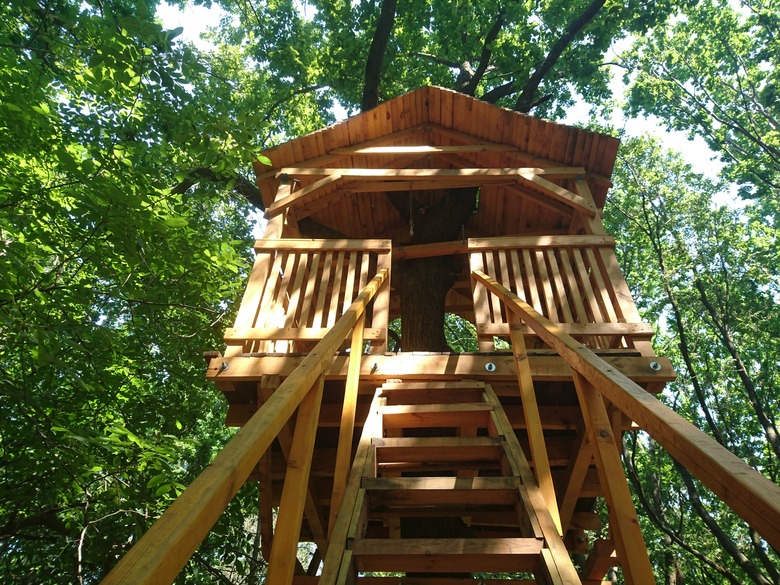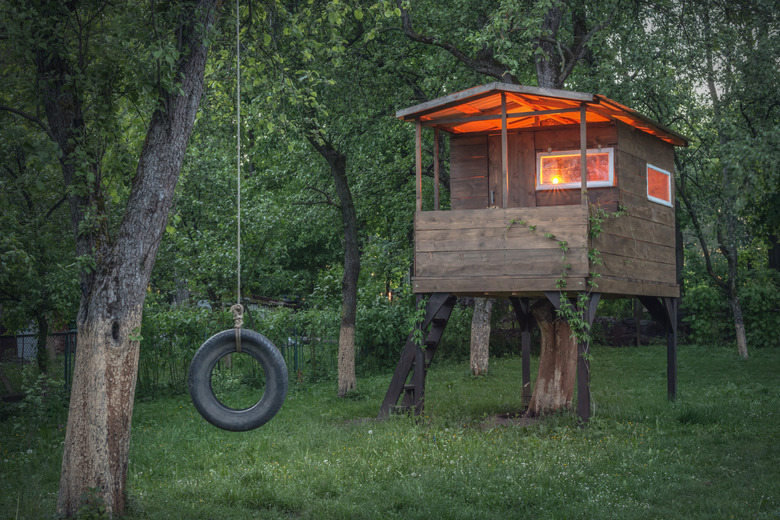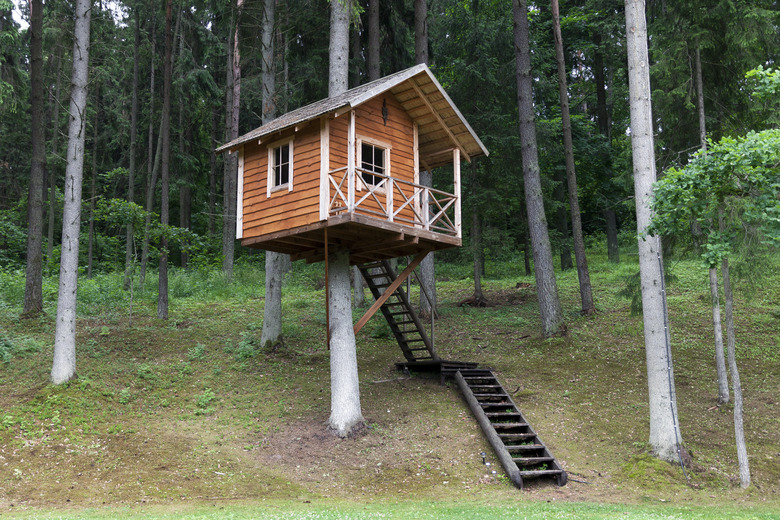How To Find The Best Tree For A Treehouse
You've decided to build a treehouse, and the kids are understandably excited, but before you start, it's important for safety's sake to find the best tree. To build the best treehouse, you want a tree with the right branch structure that's strong enough to support it. The tree has to be in a suitable location far from roadways and other hazards, and it shouldn't be subjected to high winds that may make it sway violently. Moreover, a good tree for a treehouse should be mature and have deep roots because a treehouse won't last long if you build it on a young tree that's still growing quickly.
The best tree for your treehouse project also has to be healthy, and for this, you might need a little help. Different species of trees are vulnerable to different pests and diseases, and not all arboreal afflictions are noticeable to the untrained eye. Once you've settled on what you believe is the right tree, you should have it checked by a trained arborist who will be able to identify damage caused by burrowing insects or fungal diseases that can weaken branches.
One more factor to consider is the impact your treehouse is going to have on the tree. You'll be securing the treehouse to the trunk and branches with bolts and brackets, and these actually injure the tree, although the injuries will heal. In the process, though, the tree will compartmentalize the injury by sealing it off while growth continues around it, and this ultimately disfigures the tree. You may not want this to happen to the prize oak in your backyard.
Building a treehouse? Here's how to find the best tree possible for the project.
The Best Tree Species for a Treehouse
The Best Tree Species for a Treehouse
To support a treehouse, a tree must have dense wood, but that doesn't necessarily mean it has to be a large, old oak or maple tree. More than one coniferous species qualifies, and there are even some fruit and nut trees capable of doing the job. In some cases, it may make sense to build the treehouse on the branches of more than one tree, and you can use a combination of tree species for this. Using more than one tree to support a treehouse helps reduce the impact of the extra weight on a single tree. A heavy structure can weaken a tree and cause it to lean or droop until it has a chance to compensate by growing extra roots in the opposite direction, which can take several years.
Oak and maple are two of the best deciduous species, each having strong, dense wood for support and good pest and disease resistance for longevity. It helps that maple and oak trees are both common in North America, with subspecies that grow almost everywhere, which makes it likely that you'll have one on your property. If not, a stately sycamore or hickory tree will also do, and an apple, cherry or hemlock tree may be just as good as a maple tree depending on the branch structure.
Coniferous trees generally grow too small to support a treehouse, but there are a few exceptions, especially for people who live in the West. Both Douglas fir and redwood are large and strong enough for a treehouse, but the problem with these species is that they seldom have low-hanging branches on which to build. Redwoods grow in clumps, though, and you can often position your treehouse inside a clump and bolt it to several trunks. Just be sure to give the treehouse building a solid roof because redwoods regularly drop branches when it's windy, and some can be quite large because, after all, it's a redwood.
The Best Tree Structure
The Best Tree Structure
When you DIY your own treehouse, it's tempting to build in the treetop to take advantage of the view and the proliferation of small, supporting branches. It's safer for kids, however, to build closer to the ground, which also avoids the possibility of the treehouse turning into a sail in the wind, putting stress on the branches and breaking them.
Here's what the ideal tree for a treehouse should look have:
- One or two forks: The ideal tree has one or two forks rising from the main trunk about 10 feet above the ground, creating a notch into which you can nestle the treehouse, and it's a bonus if there are one or two large limbs there for extra support.
- Support limbs that extend at a right angle. These trees are stronger than those that grow upward at an angle, and they are also easier on which to build.
- A limb that has a minimum diameter of 8 inches. This limb, supplemented by nearby limbs from the same or a different tree, can support a smallish structure, which then gets anchored to the trunk or branches of one or more trees for security. When building on the limb of a single tree and you have only one trunk for anchoring, it may be necessary to support the outer edge of the platform with one or more posts that extend to the ground.
Warning
Trees tend to sway in the wind, so it is important to use anchoring bolts and fasteners that allow the tree to move without disturbing the treehouse structure. Some trees sway more than others, however, and a tree with a lot of sway isn't a great candidate for a treehouse. You also need to consider sway when using more than one tree for support since trees don't always sway in the same direction at the same time.
Choosing the Best Tree on Your Property for a Treehouse
Choosing the Best Tree on Your Property for a Treehouse
You may have more than one tree on your property with the right structure for a treehouse, so consider other factors to help you choose the best tree:
- The value of the tree: Do you consider the tree valuable? If so, choose another one because your treehouse project will damage it.
- Traffic around the tree: Similarly, you should pass on a tree that's near a trafficked area and instead choose one in a secluded area.
- HOA or city rules: Your city or homeowners' association may have rules about where you can locate a treehouse, and many do not allow them in front-yard trees (more visibility and accessibility makes treehouses enticing to trespassers).
- Plants around the tree you want to keep: Also keep in mind that there will be plenty of little feet trampling the ground around the base of the tree, so fragile ground cover and even grass may have a hard time surviving.
Once you've zeroed in on a likely prospect, you want to look for signs of pests and disease, and this may take some research. Look up common pests and diseases for the species of tree and note the signs of the damage they cause. Oak trees, for example, are vulnerable to anthracnose, a fungal infection that can weaken the tree and make it unsuitable, and one of the signs of this condition is brown blotches on the bark. A maple tree surrounded by sawdust and displaying loss of leaves at the crown could have an Asian longhorned beetle infestation, and if so, it won't last longer than a year or two.
Generally, any liquid seeping from the ends of branches or patchiness, discoloration or unseasonal loss of leaves is cause for concern. If you suspect pests or disease, the best thing you can do is have the tree inspected by an arborist, who may recommend cutting it down to prevent the condition from spreading. If so, you may have lost that tree for your treehouse project, but you may also have dodged a bullet by protecting the rest of the trees on your property from the same fate.


